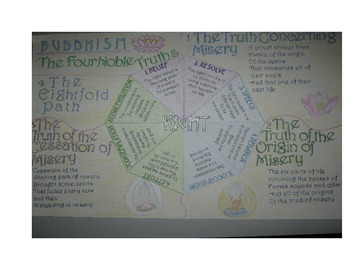The Four Noble Truths & The Eightfold Path; A Common Core Approach
Creative History
143 Followers
Grade Levels
6th - 10th
Resource Type
Standards
CCSSCCRA.R.1
CCSSCCRA.R.2
CCSSCCRA.R.3
CCSSCCRA.R.5
CCSSCCRA.R.10
Formats Included
- PDF
- Internet Activities
Pages
14 pages
Creative History
143 Followers
Compatible with Digital Devices
The Teacher-Author has indicated that this resource can be used for device-based learning.
Description
“The Four Noble Truths” are the fundamentals of Buddhism, the realization of which turned Gautama into the Buddha or the enlightened one. They are the central definition of Buddhist goals and the wellspring from which all Buddhist sects developed. The fourth noble truth is “The Eightfold Path,” the route for individuals to take in order to achieve enlightenment. That are found in the earliest texts of Buddhism in India and traveled as Buddhism moved from India to China, Korea, and eventually to Japan. The students will create a poster to explain “The Four Noble Truths” and “The Eightfold Path” using “Sutta 22” of Digha-Nikaya. It is a Common Core approach where the students read a primary source and learn to express their understanding concisely. The visual presentation aids in student retaining that important information.
Total Pages
14 pages
Answer Key
N/A
Teaching Duration
N/A
Report this resource to TPT
Reported resources will be reviewed by our team. Report this resource to let us know if this resource violates TPT’s content guidelines.
Standards
to see state-specific standards (only available in the US).
CCSSCCRA.R.1
Read closely to determine what the text says explicitly and to make logical inferences from it; cite specific textual evidence when writing or speaking to support conclusions drawn from the text.
CCSSCCRA.R.2
Determine central ideas or themes of a text and analyze their development; summarize the key supporting details and ideas.
CCSSCCRA.R.3
Analyze how and why individuals, events, and ideas develop and interact over the course of a text.
CCSSCCRA.R.5
Analyze the structure of texts, including how specific sentences, paragraphs, and larger portions of the text (e.g., a section, chapter, scene, or stanza) relate to each other and the whole.
CCSSCCRA.R.10
Read and comprehend complex literary and informational texts independently and proficiently.





